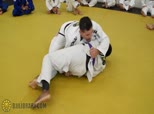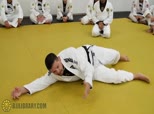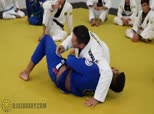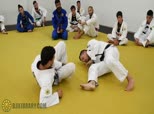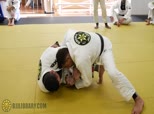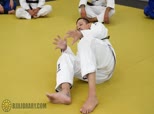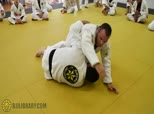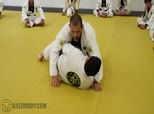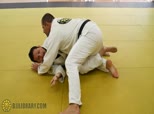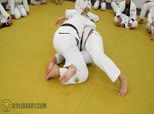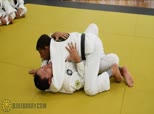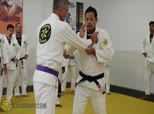Inside the University 539 - Hand Positioning when Turning Belly Down
Add to Favorites 764 Remove From Favorites 2333 days ago
Now Saulo points out that your hands should stay under your body when turning belly down. Many times people will reach for the legs and get stuck because of this. If you are reaching for the legs, it should be in effort to take your opponent down. However, in this case, we are looking to recover guard, so he keeps his hands near his body for protection.Inside the University 538 - Avoiding Turtle when Turning Belly Down
Add to Favorites 886 Remove From Favorites 2334 days ago
Tying all his movements together, Saulo shows how to avoid getting stuck in turtle when turning belly down. After escaping his hips and bringing his bottom leg through, he doesn't hang out on his knees, allowing his opponent to set up attacks. Instead he brings his other leg to S position and falls back, where he can reset his guard.Inside the University 537 - Framing Before Recovering
Add to Favorites 847 Remove From Favorites 2335 days ago
Now Saulo focuses on the importance of recovering guard with two specific movements after turning on his side. When he brings his knee in the first time, this is to set his frame. He is not yet looking to recover because he doesn't have the space. Next he escapes his hips, and now he has the space to bring his knee in more and begin to recover.Inside the University 536 - Back and Forth Hip Movement
Add to Favorites 736 Remove From Favorites 2337 days ago
Saulo breaks down the fundamental movement of the hips while recovering guard. After his bridge, while still on his side, he is using a back and forth motion to gain momentum, whether he goes to recover guard or turn belly down. If he recovers, his inside leg now becomes a frame against his opponent's body, and a new point of leverage to use.Inside the University 535 - Recovering Guard when Your Opponent Passes Your Legs
Add to Favorites 906 Remove From Favorites 2338 days ago
Saulo's opponent is passing his guard, so as soon as he gets around the legs, Saulo's first move is to turn on his side at his 45 degree angle, with both elbows attached to his body. His opponent drops his weight to put pressure, so Saulo bridges to create space. If he now has room to move his hips, he brings his legs in to recover guard.Inside the University 534 - 45 Degree Hip Escape
Add to Favorites 877 Remove From Favorites 2339 days ago
Now progressing to defense when your opponent is already going around your legs, Saulo discusses the concept of the 45 degree hip escape. Where many people fully extend themselves to a 90 degree hip escape, Saulo points out the flaw in this and shows how just going 45 opens up many more options to bridge, recover, turn belly down and so on.Inside the University 533 - Taking the Back from Half Guard
Add to Favorites 907 Remove From Favorites 2340 days ago
From the half guard, Saulo bridges and gets the underhook, keeping his hand closer to the side of the back rather than reaching across, to protect from the whizzer. Now he switches his legs, using his outside leg as his hook. He opens his elbow and turns to his shoulder, opening space for him to get to his knees and sneak out the back door, ready to attack his opponent's back.Inside the University 532 - Using the Bridge to Create Space
Add to Favorites 699 Remove From Favorites 2341 days ago
When turning to block with your shoulder, it is important that you don't turn too far that you start facing the mat. Stop when your shoulder is in your opponent's chest. Also, any action taken from here must begin with a bridge. Whether you're going for the underhook or looking to recover, the bridge will create the space you need.Inside the University 531 - Proper Framing from Half Guard
Add to Favorites 891 Remove From Favorites 2342 days ago
Now Saulo focuses on the proper framing techniques to use while on bottom in half guard. Rather than trying to push his opponent away with his hands, he turns to his side, making a block with his shoulder and letting his hand on the ground. From here, he can bridge and bring his arm out to make an underhook. Another option is to frame both hands on the biceps, and hip escape to create the space needed to recover guard.Inside the University 530 - Bridging Mechanics from Half Guard
Add to Favorites 827 Remove From Favorites 2344 days ago
Correcting a couple mistakes he saw his students making, Saulo shows not to put your hook leg too deep in the half guard. This mistake will keep you from being able to escape your hips as much as you need to create the space to recover guard. Also, it is important when you bridge that you don't throw your arm over the top of your opponent's head. Keep it on the nearside for better leverage and control.Inside the University 529 - Bridge Escape from Half Guard
Add to Favorites 848 Remove From Favorites 2345 days ago
Saulo is on bottom in half guard, and his opponent has the underhook and head control, which is the worst spot he can be in now. First, Saulo hooks his opponent's leg with his inside leg, rather than crossing his legs and locking himself flat. Next he makes sure his elbow is tight to his ribs. Now he pushes off his outside foot to bridge, and uses the inside of his other elbow to push the top of the head to the inside. Here he can bring his knee inside across the hips, and push to extend his body, creating the space he needs to recover his guard.Inside the University 528 - Grip Breaking
Add to Favorites 621 Remove From Favorites 2346 days ago
During the stand up fight, Saulo's opponent has the traditional collar and sleeve grip, as does Saulo. To break, he slides his hand down from the triceps to the end of the sleeve. His other hand cups the inside of the wrist, and he leans back as he pushes the wrist to break the collar grip. Now to break the sleeve grip, he aggressively pulls his arm and pivots about 90 degrees.
